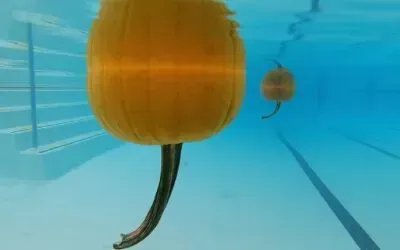Swimming Pumpkins? A Fun Way to Learn About Buoyancy

Pumpkin Week starts on Friday, October 23rd, and it is my absolute favorite week of the year. The kids get super excited to see the pumpkins (their Halloween pumpkins) floating around our pool. They get to see the big pumpkins as well as the little ones bobbing and moving with the waves and they see each other hanging on and floating with them.

While Pumpkin Week is fun and exciting and something a little different, it serves a vital importance, and that is in teaching floating. Floating is probably the number one, most important skill to teach your child–not breathing, not freestyle, not treading water–FLOATING!
Floating is so important because it is the foundational building block to actually swimming. Floating teaches you to relax in the water. (You can’t float when you are panicked.) Floating teaches you your own buoyancy. While floating, you can do small movements with your arms and legs and reach a destination. Floating on your back will help you breathe, and good floats with arms and feet added becomes swimming. This holds true for breaststroke and butterfly as well.
The need to be horizontal in the water is essential to good swimming and floating teaches us this. It is why we practice it so much in level 1 and 2, but also reinforce it in level 3, 4, & 5. I’m sure once parents notice their child putting their face in the water and floating on their bellies, all of a sudden, swimming “clicks.” Now, even a two or three year old can “swim” a few feet through the water–it is because the child is completely horizontal and floating. For example, my student Gus, who is 5 years old, just figured this out this week. Gus started as a Red/Orange in the beginning of the Fall Session. He was not an afraid swimmer and had no problem getting splashed in the face or going underwater (briefly) during jumps. Within a few weeks, he was dipping his face for longer and longer periods of time, starting with 1 second and eventually increasing it to 5-6 seconds. Once he became comfortable dipping his face, even for a second, we added it to our crocodile walks, because crocodile walks force children to be horizontal (even though hands are down on the steps, their legs are stretched out behind them). As Gus got more comfortable with his face in and legs out, he was able to start feeling his own buoyancy, which led to him being able to trust the water to hold him up. This was demonstrated in his front floats. He started with holding onto my arms and dipping his face. Eventually, his face would stay in just a little longer and a little longer. Then, his grip on my arms would loosen and I would start to loosen my grip on him. He began to feel the water hold him up. Once he learned to dip his face for longer periods of time, he moved up to Orange. This week, Gus decided he wanted to go underwater and you could see his comfortability in going under (and not listening to me, lol). This week, in going underwater and in putting his face underfor supermans (or torpedoes), he figured out that when his face goes in, his butt and legs come up and he can paddle around like that. And because Gus is now underwater and ignoring me, he graduated to level 2, Orange/Yellow. (That’s how we know kids should be in level 2; they want to swim around underwater; they don’t care what their teachers are talking about =). But before parents get upset that your child might not be listening to us, let me tell you right now, that’s a good thing! Your child knows how to float and before long, he or she will be off swimming around (and being more dangerous in the water because they don’t know their limitations, but that is another post for another time). Gus is an exception, however. Gus is older (5 years old), he was not afraid, he has a natural athletic ability, and he was in a private lesson–which all make teaching him a little bit easier.
So what does all this have to do with pumpkins? Well, pumpkins float. Big pumpkins, little pumpkins, all pumpkins float–even the 800+ pound one sitting out front. Pumpkins float because they have air in them and we float for the same reason. Now, we aren’t just talking about hypothetical theories. We are learning science (Archimedes Principle) and we are experiencing and demonstrating that science to our kids. And hopefully, while seeing these pumpkins, as big as they are, our kids realize that they too, can float.
The post Swimming Pumpkins? A Fun Way to Learn About Buoyancy appeared first on Swim-in Zone Swimming Academy.



